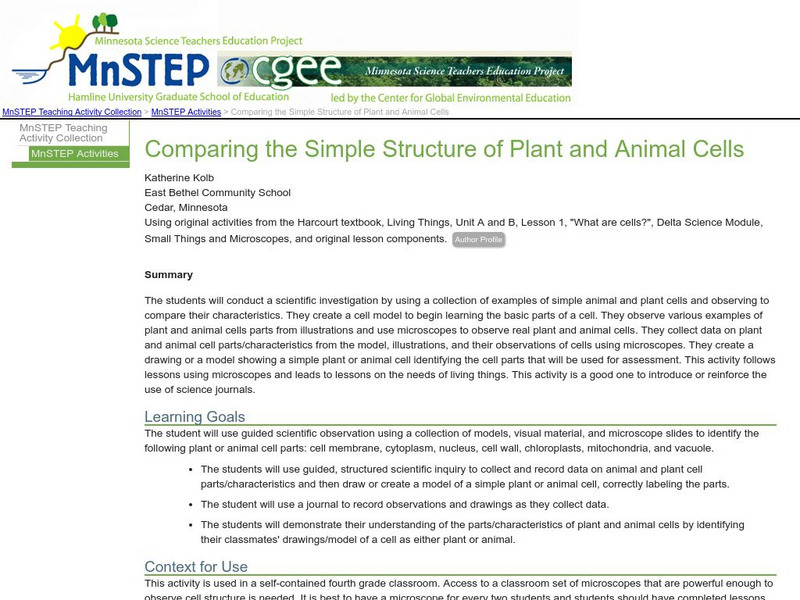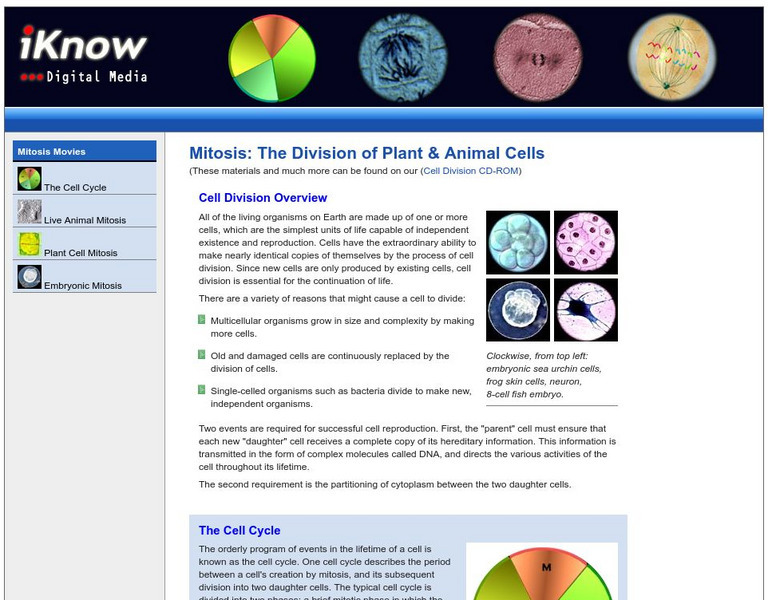Hi, what do you want to do?
Curated OER
How Can We Study the Differences in Animal and Plant Cells Using the Compound Microscope?
Students examine their cheek cells with a compound microscope. They identify different parts of the cell. They compare and contrast animal and plant cells with the microscope as well.
Science Matters
Structure-Function
Without structure, there wouldn't be function. Scholars examine the meaning of structure and function with a hands-on experience. Using balls from different sports, they compare and contrast their structures and then analyze how each...
Curated OER
Life Processes and Water
Explain the properties of water. Identify the properties of water that make it a polar molecule Describe hydrogen bonds and how they differ from covalent bonds Discuss the differences between hard water and soft water Compare the heat of...
Curated OER
Classification/Taxonomy/Statistics Review
"Does King Phillip Cry Over Flimsy Grass Stems?" You might not answer that question with this exhaustive worksheet, but your biology class will get the full scoop on the hierarchy of biological classification with this resource. It...
Curated OER
Cloning Animals and Plants: Any Difference?
Students examine the process in which plants and animals are cloned. They compare and contrast the two procedures and determine if there is a difference. They share their views on cloning to the class.
Curated OER
Graze Like a Cow
Students explore how a cow digests the grass they eat. For this science/math lesson, students compare the quality of forage. Additionally, students determine the effects of rangeland health on the production.
Curated OER
The Five Kingdoms
An overview of the five kingdoms within the biological classification system is presented in this set of five slides. The first lists the objectives of the slide show, and the second gives general characteristics of plant, animal, and...
Curated OER
Feedback and Flowcharts
Sixth graders explain what a negative feedback system is and they distinguish it from a positive feedback system. They describe examples of how negative feedback is used in both nature and technology. , Students define homeostasis, and...
Curated OER
DNA Extraction Lab
Students extract DNA and test for its presence from unroasted (raw) wheat germ using a prescribed procedure. They modify the procedure to provide a less expensive, easier method. They also extract DNA from different available plant,...
Curated OER
Outdoor Survival
Students are introduced to basic outdoor survival concepts. They identify the seven basic needs for survival. Students describe the symptoms and treatment for frostbite and hypothermia. They compare and contrast the value of different...
Alabama Learning Exchange
Mitosis: Divide to Survive
Learners identify the purpose of cellular mitosis. They work in groups of four to use images of animal and plant cell mitosis to illustrate each step in the mitosis process on their graphic organizer.
Curated OER
Light Microscopes
Seventh graders study the parts of a light microscope, and its proper use. They identify each part and explain why it is important to know how to use this tool. They practice observing newsprint on a wet mount slide.
Curated OER
Woodland Math Facts
In this Woodland math facts worksheet, students study and examine woodland weights of trees and shrubs, explore invertebrates and draw a bar chart to chart their findings.
Curated OER
Goals of the Diversity of Life Unit
Students are introduced to the unit on the importance of diversity of life and the role that interdependence plays in our worlds. this is part of a multi-lesson unit on the diversity of life.
Curated OER
DNA Extraction From a Variety of Tissue Samples
Pupils, working in cooperative groups, extract very impure samples of DNA from a number of tissue samples. They determine how the samples can be preserved and how they are similar.
Curated OER
Mountains in the Sea Exploration No Escape
Students study data to hypothesis about the influence of a water circulation cell on the retention of benthic invertebrate larvae in the area of a seamount. They investigate the positives and negatives of larvae retention in this series...
Soft Schools
Soft Schools: Comparing Plant and Animal Cells Quiz
Take an interactive quiz over plant and animal cells. After completing the quiz, check your score, and then revisit any incorrect question for further review.
Science Education Resource Center at Carleton College
Serc: Comparing the Simple Structure of Plant and Animal Cells
Students use guided scientific observation using a collection of models, visual material, and microscope slides to identify cell organelles. Then they demonstrate their understanding of the parts/characteristics of cells by identifying...
Alabama Learning Exchange
Alex: Cells
Learners will research prokaryotic and eukaryotic cells. The students will then research plant and animal cells, comparing and contrasting the two. Learners will also research the major organelles and the function of each. Students will...
My Science Site
Bj's Science: Cells: Teacher Information [Pdf]
Reference information about the study of cells. Includes a chart comparing plant and animal cells and one examining the structure of a cell.
Science Education Resource Center at Carleton College
Serc: Observe, Describe, Compare and Contrast Cells
This investigation allows learners to observe cells from multiple sources. Plant, animal and bacterial cells will be observed as well as cells from multicellular organisms and single-celled organisms. After providing written descriptions...
Other
I know.net: Mitosis
A complete site from iKnow.net that compares the various phases of mitosis in plant and animal cells. Text is supplemented with pictures of each phase.
Curated OER
I know.net: Mitosis
A complete site from iKnow.net that compares the various phases of mitosis in plant and animal cells. Text is supplemented with pictures of each phase.
Curated OER
I know.net: Mitosis
A complete site from iKnow.net that compares the various phases of mitosis in plant and animal cells. Text is supplemented with pictures of each phase.
























![Bj's Science: Cells: Teacher Information [Pdf] Handout Bj's Science: Cells: Teacher Information [Pdf] Handout](https://static.lp.lexp.cloud/images/attachment_defaults/resource/large/FPO-knovation.png)

